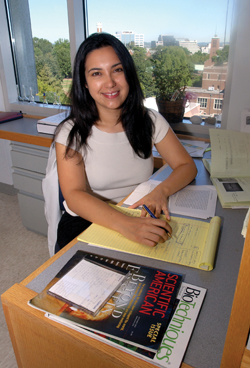
Nicole Garbarini spent the summer working at the popular journal Scientific American. (photo by Anne Rayner)
Graduate student has the ‘write’ stuff
Nicole Garbarini, a fifth-year Ph.D. student in the Neuroscience Graduate Program, got a taste of life outside the lab this summer.
Through a fellowship sponsored by the American Association for the Advancement of Science (AAAS) and the American Physiological Society, Garbarini spent 10 weeks working the “beat” of a science writer at the popular science publication Scientific American. Two of Garbarini’s contributions are featured in the “News Scan” columns of the September and October issues.
Now in its 30th year, the AAAS Mass Media Science and Engineering Fellows Program has helped more than 450 fellows explore careers in science journalism. Fellows gain experience reporting science news at radio and television stations, newspapers and magazines across the country. About half of program alumni, who include Joe Palca and David Kestenbaum of National Public Radio, have gone on to careers in science journalism.
Garbarini’s interest in science journalism makes perfect sense if you know her background. She was editor of her high school newspaper and the high school literary magazine. As a biology major at Oglethorpe University in Atlanta, Garbarini minored in English and served as editor-in-chief of her college newspaper.
“I’ve always been very interested in writing, but I was also fascinated by biology and the sciences,” Garbarini said. “I wanted a taste of each.”
When Garbarini saw an announcement for a biology haiku contest, she got to combine her two passions.
“I wrote one while I was standing in the hall waiting for class and sent it in,” Garbarini recalls. Her haiku about DNA (below) won third place in the contest.
“Encrypted secrets
in nucleotide spirals –
the genetic code.”
After graduating with a bachelor’s degree in biology, Garbarini came to Vanderbilt to immerse herself in the inner workings of the brain. In the lab of Eric Delpire, Ph.D., associate professor of Anesthesiology and Molecular Physiology and Biophysics, she began searching for proteins that interact with KCC2, a protein that plays a critical role in regulating the electrical excitability of brain cells.
Although she enjoyed the research, her penchant for prose persisted. She heard about the AAAS fellowship soon after she started graduate school, but decided to put her writing aspirations on hold to concentrate on research.
During her fourth year in graduate school, the time seemed right. Of course, taking such a detour during graduate school could delay progress toward her degree. But with the support of her closest advisors, Garbarini decided it was a chance worth taking.
“Aside from bench work, there are additional exciting opportunities for clever students to catch,” said Delpire, Garbarini’s graduate advisor. “As a mentor, you have to encourage your student’s abilities and aspirations. I never doubted that it would be a very successful experience for Nicole. She is a well grounded, very responsible individual.”
“When Nicole came to talk to me about applying for the fellowship, I was highly supportive,” said Elaine Sanders-Bush, Ph.D., the director of the Neuroscience Graduate Program. “Such hands-on experience would be an extraordinary experience, since Nicole had expressed an interest in a scientific writing career throughout her graduate training. I felt confident that Nicole had the talent and motivation to make the most of the fellowship.”
In April, Garbarini got the news that she was going to New York City to write for Scientific American. Although she had previously written for newspapers, going to a major magazine was a totally new experience.
“It’s a very intense field…it was invigorating,” Garbarini said of the magazine business. In her two months there, Garbarini explored frontiers of science she would not have had time for in graduate school. In her first major news piece, she reported on the creation of artificial retinas. In her most recent article, Garbarini describes the physiological effects of reading hexametric prose — the writing style used in Homer’s Odyssey.
Being a scientist-turned-writer has advantages and disadvantages. “As a scientist I want to make sure I have the details correct,” Garbarini said. Her science background allowed her to easily grasp complex scientific concepts.
But knowing “too much” science also can hinder the process of writing for a general audience. The technical jargon and straightforward writing style to which scientists are accustomed to can be hard habits to break.
“I think you just have to keep the audience in mind,” Garbarini said. “For a scientific journal article, the audience understands the background of your work. In journalism, you have to address how (the science) will affect the reader.”
For now, it’s back to the bench to complete her Ph.D., but she keeps an open mind about what her future holds, whether it’s writing, research, or something else entirely.
The experience has had effects beyond just learning about journalism. “I’m even more enthused about my work here,” Garbarini said. “It reminded me how cool science is.”
The AAAS Mass Media Science and Engineering Fellows Program is open to graduate, advanced undergraduate, and postdoctoral students in science, engineering and medicine.













